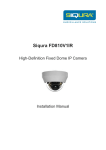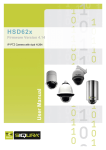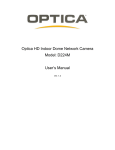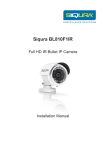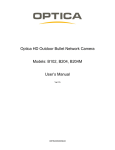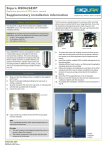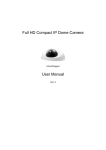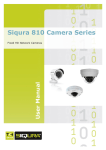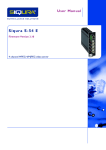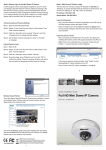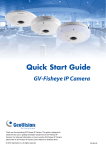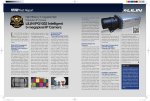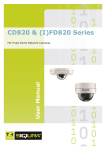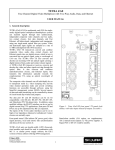Download English - Siqura
Transcript
Siqura CD810F1 Compact Fixed Dome IP Camera Installation Manual Table of Contents 1. 2. Overview ................................................................................................................................ 3 1.1 Features ...................................................................................................................... 3 1.2 Package contents ........................................................................................................ 4 1.3 Dimensions .................................................................................................................. 5 1.4 Power and Ethernet connectors ................................................................................... 5 1.5 Install the camera ........................................................................................................ 6 1.6 Connectors .................................................................................................................. 7 Camera cabling ..................................................................................................................... 8 2.1 Connect power ............................................................................................................ 8 2.2 Connect the Ethernet cable ......................................................................................... 8 3. System requirements .......................................................................................................... 10 4. Access the camera.............................................................................................................. 11 4.1 Connect via web browser........................................................................................... 11 4.2 Connect via Siqura Device Manager .......................................................................... 11 4.3 Change network settings ........................................................................................... 12 4.4 Log on to the camera ................................................................................................. 13 4.5 Siqura Viewer ............................................................................................................ 13 4.6 Home page ................................................................................................................ 14 5. Set up video resolution....................................................................................................... 15 6. Export/Import configuration files ....................................................................................... 16 7. Tech support information ................................................................................................... 17 7.1 Delete the existing Siqura Viewer .............................................................................. 17 7.2 Set up Internet Security ............................................................................................. 18 [2] 1. Overview The CD810F1 can provide real-time video streaming and smooth image quality. The camera offers MJPEG streaming and also includes an H.264 encoder for high-resolution digital broadcast applications. With its compact and sophisticated mechanical design, the CD810F1 camera is easily installed and aesthetic in appearance. 1.1 Features Progressive scan CMOS sensor 2 Mpixel resolution Full HD 1080p resolution Dual-stream H.264 and MJPEG video Multilanguage support Tampering alarm Wide dynamic range Motion detection Privacy masks Smart picture quality / 3D noise reduction Vertical view mode (image rotation by 90 degrees) Network failure detection Audio: built-in microphone microSD support ONVIF support [3] 1.2 Package contents CD810F1 Security torx Barrel connector adapter Self-tapping screw (x3) Plastic screw anchor (x3) Quick Start Guide Software and manuals NOTE: The supplied self-tapping screws are for soft substances / materials such as wood. For other installation environments, such as cement wall, it is required to pre-drill and use plastic anchors before fastening the supplied self-tapping screws to the wall. [4] 1.3 Dimensions 1.4 Power and Ethernet connectors 1 No. 1 2 Connector RJ-45 Power Jack (DC 12 V) 2 Definition For network and PoE connection Power connection [5] 1.5 Install the camera Step 1: Loosen the two security screws of the camera and detach the dome cover. Step 2: Place the camera at the installation location. Then attach the camera to the ceiling by fastening it with the supplied screws through the screw holes. Step 3: Refer to section Connectors and chapter Camera Cabling for camera lens adjustment and cable connection. Step 4: Attach the dome cover back to the camera and fasten the two security screws. [6] 1.6 Connectors No. Item 1 Reset Button 2 Lens Description Press the button with a proper tool for at least 20 seconds to restore the system to the factory-default settings. Rotate the lens right/left to adjust focus 3 Focus Fixed Screw Loosen the screw to adjust the lens 4 Tilt Fixed Screw Loosen the screw to adjust tilt angle 5 microSD Card Slot For video recording storage NOTE: It is not recommended to record with the microSD card for 24/7 continuously, as it may not be able to support long term continuous data read/write operations. Contact the manufacturer of the microSD card for information regarding the reliability and the life expectancy. . [7] 2. Camera cabling Before you connect cables, make sure that all cables and the power adapter are placed in dry and well-waterproofed environments, such as waterproof boxes. The purpose is to prevent moisture accumulation inside the camera and moisture penetration into cables, which might lead to camera breakdown. Follow the instructions below to complete the IP camera connection. 2.1 Connect power You can use a DC 12 V power adapter and connect it to the camera and the power outlet or you can use an Ethernet cable and connect it to the RJ-45 connector of the camera and a PoE switch. See the section below for Ethernet cable connection. 2.2 Connect the Ethernet cable For best transmission quality, cable length shall not exceed 100 metres. Connect one end of the Ethernet cable to the RJ-45 connector of the camera. Connect the other end of the cable to the network switch. The Ethernet connector of the indoor camera is shown as below. PoE Connection Before connecting Ethernet cable, loosen the two security screws of the indoor camera and detach the dome cover. [8] Connect one end of the Ethernet cable to the RJ-45 connector of the indoor camera, and plug the other end into a PoE switch. Check the status of the link indicator and the activity indicator LEDs. If the LEDs are unlit, check the LAN connection. A green link light indicates a good network connection. An orange activity light flashes for network activity indication. NOTE: Please use an Ethernet cable without the boot cover to connect the indoor camera. Otherwise, the dome cover cannot be installed. After cable connection, attach the dome cover back to the indoor camera and fasten the two security screws. [9] 3. System requirements To control the IP camera via a web browser, connect the camera to a PC over the network and meet the system requirements as described below. Items System Requirement Personal computer 1. Intel® Pentium® M, 2.16 GHz or Intel® CoreTM2 Duo, 2.0 GHz 2. 2 GB RAM or more Operating system Windows 7 or higher Web browser Microsoft Internet Explorer 6.0 or later Firefox Chrome Safari Network card 10Base-T (10 Mbps) or 100Base-TX (100 Mbps) operation Viewer ActiveX control plug-in for Microsoft IE [10] 4. Access the camera You can log on to the webpages of the CD810F1 from a PC which is on the same subnet as the camera. You can open the login page directly from your web browser or use Siqura Device Manager to access the camera. 4.1 Connect via web browser To connect to the camera via a web browser 1. Open the web browser. 2. Type the IP address of the CD810F1 in the address bar, and then press ENTER. The factory-set IP address of the camera is in the 10.x.x.x range. You will find it printed on a sticker on the camera. If your network configuration is correct you are directed to the login page of the camera. 4.2 Connect via Siqura Device Manager With Siqura Device Manager - a tool included on the supplied Siqura Product CD - you can locate, manage, and configure Siqura IP cameras and video encoders. To connect to the camera via Siqura Device Manager 1. Start Siqura Device Manager The network is scanned. Detected devices appear in the List View pane. 2. Use the tabs in the Tree View pane to define the scope (subnet) of your search. 3. Click the column headings in the List View pane to sort devices by type, IP address, or name. 4. To connect to the webpages of the CD810F1, double-click its entry in the device list, - or Right-click the entry, and then click Open Web Page. The login page of the camera is opened in your web browser. [11] 4.3 Change network settings With Siqura Device Manager, you can directly change the network settings of the CD810F1. To assign a static IP address 1. Go to the list of detected devices, and then right-click the entry for the CD810F1. 2. Click Change Network Settings. 3. In Change Network Settings, click Static IP. 4. Provide the camera with an appropriate IP address, netmask, and gateway address for the desired network configuration, and then click OK. 5. In the pop-up window indicating that you have successfully changed the settings, click OK. 6. Wait one minute, and then rescan the network. 7. To access the webpages of the camera, double-click its entry in the list of found devices. To assign a DHCP server 1. Go to the list of detected devices, and then right-click the entry for the CD810F1. 2. Click Change Network Settings. 3. In Change Network Settings, click Enable DHCP, and then click OK. 4. In the pop-up window indicating that you have successfully changed the settings, click OK. 5. Wait one minute, and then rescan the network. 6. To access the webpages of the camera, double-click its entry in the list of found devices. Note: A DHCP server must be installed on the network in order to provide DHCP network support. [12] 4.4 Log on to the camera Users with a valid account for the CD810F1 can log on to the camera. To log on 1. In the Authentication box, log on with the account that was created for you. User name and password are case sensitive. The default user name set at the factory for the CD810F1 is "Admin" with password "1234". 2. Click Log In. Note: To prevent unauthorised access from people using the default account, we recommend that the administrator changes the default password after first login and creates separate user accounts as needed. 4.5 Siqura Viewer For the initial access to the camera, a client program, Siqura Viewer, is automatically installed to the PC when connecting to the camera. If the web browser doesn’t allow Siqura Viewer installation, check the Internet security settings or ActiveX controls and plug-ins settings (see section Set up Internet Security to continue the process. An information bar may pop up and ask for permission to install the ActiveX control for displaying video in browser. Click <Install> to allow the installation. Then a security warning window pops up. Click <Yes> to install the software. Click <Finish> after the Siqura Viewer installation has completed. [13] 4.6 Home page Once the Siqura Viewer is successfully installed, the home page of the IP camera is displayed as in the figure below. Note that function buttons will vary depending on the camera model. For a description of the CD810F1 webpages, see the User Manual on the supplied Siqura Product CD (download the latest version at www.siqura.com). [14] 5. Set up video resolution Users can set up the video resolution on the Video Format page of the browser-based configuration interface. Video Format can be found under this path: Streaming> Video Format. The default values of video resolution are as below. 2M H.264- 1920 x 1080 (13/15 fps) + H.264- 720 x 480 (13/15 fps) 2M Real-time H.264- 1920 x 1080 (25/30 fps) + H.264- 720 x 480 (25/30 fps) For more details about the combinations of video resolution, see the User Manual. [15] 6. Export/Import configuration files To export/import configuration files, users can access the Maintenance page on the browser-based configuration interface. The Maintenance settings can be found under this path: System> Maintenance. Users can export configuration files to a specified location and retrieve data by uploading an existing configuration file to the IP camera. It is especially convenient to make multiple cameras have the same configuration. Export Users can save the system settings by exporting the configuration file (.bin) to a specified location for future use. Click the <Export> button, and the pop-up File Download window is displayed. Click <Save> and specify a desired location for saving the configuration file. Upload To upload a configuration file to the IP camera, click <Browse> to select the configuration file, and then click the <Upload> button for uploading. [16] 7. Tech support information This chapter explains how to delete a previously installed Siqura Viewer from the PC and how to set up the Internet security. Note: For the technical specifications of the camera, refer to the CD810F1 datasheet. 7.1 Delete the existing Siqura Viewer Viewing camera images in the CD810F1 webpages requires Siqura Viewer software. You are strongly advised to remove a previous installation of Siqura Viewer from your computer before initial access to the camera over the network or when you encounter an "A new version is available" message. To uninstall Siqura Viewer 1. On the Windows Start Menu, click Control Panel. 2. Click Programs and Features. 3. On the installed programs list, select Siqura Viewer. 4. Click Uninstall. Deleting the files in your Temporary Internet Files folder may improve your web browser performance. To delete the Temporary Internet files 1. Open your web browser. 2. On the Tools menu, select Internet Options. 3. In the Browsing history section of the General tab, click Delete. 4. Select Temporary Internet files, and then click Delete. [17] 7.2 Set up Internet Security If ActiveX control (Siqura Viewer) installation is blocked, set the Internet security level to default or change the ActiveX controls and plug-ins settings. To set the Internet Security level to default 1. Start Internet Explorer (IE). 2. 3. 4. 5. 6. On the Tools menu, select Internet Options. Click the Security tab, and then select the (logo of the) Internet zone. Under Security level for this zone, click the Default Level button. Click OK to confirm the setting. Close the browser window, and start a new session later to access the camera. To modify ActiveX Controls and Plug-ins settings 1. Start Internet Explorer (IE). 2. On the Tools menu, select Internet Options. 3. Click the Security tab, and then select the (logo of the) Internet zone. 4. Under Security level for this zone, click the Custom Level button. The Security Settings - Internet Zone dialog box displays. 5. Under ActiveX controls and plug-ins, set all items listed below to Enable or Prompt. Note that items may vary from one IE version to another. Allow previously unused ActiveX controls to run without prompt. Allow Scriptlets. Automatic prompting for ActiveX controls. Binary and script behaviors. Display video and animation on a webpage that does not use external media player. Download signed ActiveX controls. Download unsigned ActiveX controls. Initialize and script ActiveX controls not marked as safe for scripting. Run ActiveX controls and plug-ins. Script ActiveX controls marked safe for scripting. 6. Click OK to accept the settings and close the Security Settings box. 7. Click OK to close the Internet Options dialog box. 8. Close the browser window, and start a new session later to access the camera. © Siqura B.V. 2015 Version 1.1 (142411-1.1) CD810F1 IM MW10 001B01WXZ2A7-1.7 [18]



















